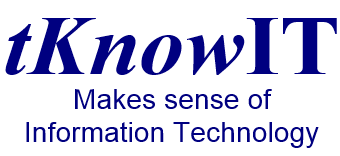E-Mail Tips: keeping your mailbox safe and tidy
 Last month I discussed changing your email address to one that was independent of your ISP. This month I will hopefully give you some useful tips on how to keep your mailbox clean and free of spam.
Last month I discussed changing your email address to one that was independent of your ISP. This month I will hopefully give you some useful tips on how to keep your mailbox clean and free of spam.
Create folders to store emails from the same category. Read an email and then either delete it or move it to the appropriate folder.
Depending upon the email program you are using you may also be able to set rules or filters which will automatically move emails from certain people or organisations into a specific folder.
Regularly empty your Bin and never use it as a folder to store files that you’ve read but may wish to refer to later – some people do this and wonder where their emails went if they run a PC clean-up utility.
Think twice before opening an email from an address you do not recognise. Look at the address and also the summary/subject field to help you decide if it looks like a legitimate email. E-mails offering free gifts are generally not genuine. If in doubt – delete!
If you have a junk folder or spam filtering service then use caution when checking the contents of these folders – but do check them as genuine emails may fail some of the tests and get deposited there. Use whitelists to make your filtering service bypass the normal checks for people you know well and, more importantly, trust.
 Be careful when trying to remove yourself from a mailing list. Lawful mailing lists will have simple instructions that will remove you from their systems but the dodgy ones may take this as a confirmation that your address is live and start sending you more unsolicited email and share (or even sell) your address with others. The easiest way to avoid problems is to use a mailbox rule or add the address to the spam filtering services blacklist so they always disappear from your main inbox view.
Be careful when trying to remove yourself from a mailing list. Lawful mailing lists will have simple instructions that will remove you from their systems but the dodgy ones may take this as a confirmation that your address is live and start sending you more unsolicited email and share (or even sell) your address with others. The easiest way to avoid problems is to use a mailbox rule or add the address to the spam filtering services blacklist so they always disappear from your main inbox view.
Turn off the reading pane or preview pane. Just like opening an infected email can lead to an infected machine, so can having these turned on make it easier for an infection to enter your computer.
Create a disposable email address. Even if you have a web-based email address with google, yahoo or Hotmail it can be useful to have a second address that you can enter on websites that are likely to then deluge you with emails that you don’t really want to receive. Keeping it as a web-based address also reduces the risk of downloading an infected or boobie-trapped email to your computer.
Never reply to unsolicited emails. Simply delete them. They are generally from automated systems and if you reply then you are only confirming that your email address is live and they can send you more rubbish and pass on your details to others.
